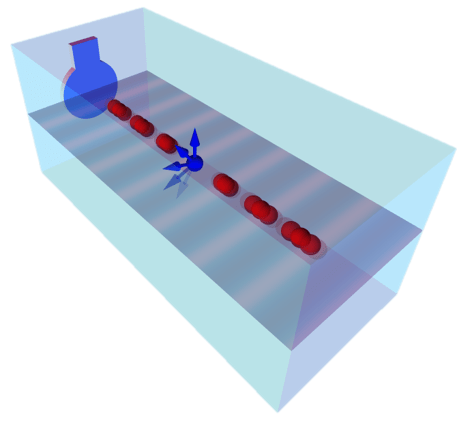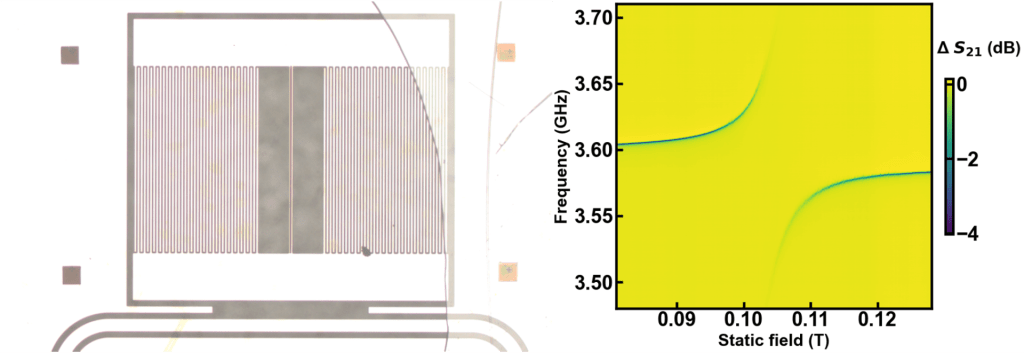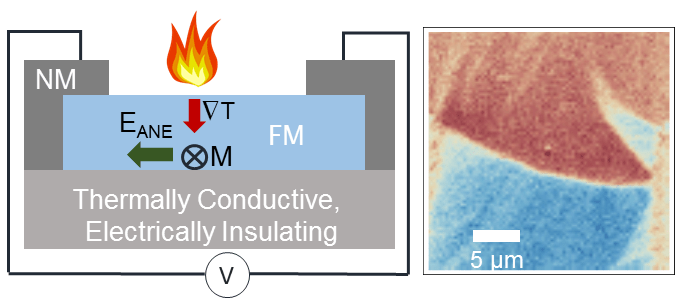Diamond NV centers for precision measurement and quantum control
 Individual nitrogen vacancy (NV) defect center spins in diamond form a unique platform to study the quantum properties of matter because they are simple, they can be studied one at a time, and they have quantum coherence even under ambient conditions. Because NV centers are point defects, they can be used to sense magnetic fields with high spatial resolution provided that they are close to the surface of the diamond host. We are currently focused on developing effective methods of robust quantum control, making use of gigahertz frequency magnetic fields and gigahertz frequency lattice strain. These studies shed light on fundamental interactions between spins, electromagnetic fields, and phonons, but also may find application in magnetometry, inertial sensing, and quantum information processing.
Individual nitrogen vacancy (NV) defect center spins in diamond form a unique platform to study the quantum properties of matter because they are simple, they can be studied one at a time, and they have quantum coherence even under ambient conditions. Because NV centers are point defects, they can be used to sense magnetic fields with high spatial resolution provided that they are close to the surface of the diamond host. We are currently focused on developing effective methods of robust quantum control, making use of gigahertz frequency magnetic fields and gigahertz frequency lattice strain. These studies shed light on fundamental interactions between spins, electromagnetic fields, and phonons, but also may find application in magnetometry, inertial sensing, and quantum information processing.
Relevant publications:
- “Optical Readout of Coherent Nuclear Spins Beyond the NV Center Electron T1,” arXiv:2501.19235 (2025).
- “Coherent Acoustic Control of Defect Orbital States in the Strong-Driving Limit,” PRX Quantum 5, 030336 (2024).
- “Stroboscopic X-ray Diffraction Microscopy of Dynamic Strain in Diamond Thin-film Bulk Acoustic Resonators for Quantum Control of Nitrogen Vacancy Centers,”Phys. Rev. Applied 22, 024016 (2024).
- “Current-induced switching of thin film α-Fe2O3 devices imaged using a scanning single-spin microscope,” Phys. Rev. Materials 7, 064402 (2023).
- “Quantifying NV-center spectral diffusion by symmetry,” Phys. Rev. Appl. 18, 064011 (2022).
- “Acoustically driving the single quantum spin transition of diamond nitrogen-vacancy centers,” Phys. Rev. Applied 13, 054068 (2020).
- “Engineering electron-phonon coupling of quantum defects to a semi-confocal acoustic resonator,” Nano Letters 19, 7021 (2019).
- “Orbital state manipulation of a diamond nitrogen-vacancy center using a mechanical resonator.” Phys. Rev. Lett. 120, 167401 (2018).
- “Cooling a Mechanical Resonator with a Nitrogen-Vacancy Center Ensemble Using a Room Temperature Excited State Spin-Strain Interaction.” Nature Communications 8, 14358 (2017).
- “Continuous dynamical decoupling of a single diamond nitrogen-vacancy center spin with a mechanical resonator.” Phys. Rev. B 92, 224419 (2015).
- “Coherent Control of a Nitrogen-Vacancy Center Spin Ensemble with a Diamond Mechanical Resonator.” Optica, 2, 233 (2015).
- “Mechanical spin control of nitrogen-vacancy centers in diamond,” Phys. Rev. Lett. 111, 227602 (2013).
Watch a video of Greg’s lecture III at ITAMP/B2 Institute Winter Graduate School on AMO Physics where he talks about our diamond spin-mechanics work. You can also watch Greg give a seminar at Purdue from September 2016 on Nanohub.
Search for new quantum defects
 Wide bandgap materials host a zoo of optically active point defects. Our group studies the solid-state and photo-physics of single defects as a basis for quantum optical information processing and metrology. Alternatives to diamond may provide new avenues of growth, processing, and control over quantum states. Interesting candidate materials that we are currently investigating include gallium nitride, silicon carbide, and hexagonal boron nitride.
Wide bandgap materials host a zoo of optically active point defects. Our group studies the solid-state and photo-physics of single defects as a basis for quantum optical information processing and metrology. Alternatives to diamond may provide new avenues of growth, processing, and control over quantum states. Interesting candidate materials that we are currently investigating include gallium nitride, silicon carbide, and hexagonal boron nitride.
Relevant publications:
- “Purcell enhancement and spin spectroscopy of silicon vacancy centers in silicon carbide using an ultra-small mode-volume plasmonic cavity.” Nano Letters 24, 11669 (2024).
- “Room temperature optically detected magnetic resonance of single spins in GaN.” Nat. Maters. 23, 512 (2024).
- “Excited-state spin-resonance spectroscopy of V_B^- defect centers in hexagonal boron nitride.” Nat. Commun. 13 3233 (2022).
- “Spectral and spatial isolation of single tungsten diselenide quantum emitters using hexagonal boron nitride wrinkles.” APL Photonics 5, 096105 (2020).
- “Optical absorption and emission mechanisms of single defects in hexagonal boron nitride.” Phys. Rev. Lett. 119, 057401 (2017).
- “Temperature Dependence of Wavelength Selectable Zero-Phonon Emission from Single Defects in Hexagonal Boron Nitride.” Nano Letters 16, 6052-6057 (2016).
- “Polarization spectroscopy of defect-based single photon sources in ZnO.” ACS Nano 10, 1210 (2016).
- “A single-molecule approach to ZnO defect studies: single photons and single defects.” J. Appl. Phys. 116, 043509 (2014).
Quantum Magnonics
 We are interested in understanding magnetic excitations in the quantum regime. Traditionally, magnetic resonance phenomena – ferromagnetic resonance and spin waves – have been viewed as strictly classical. However, by coupling ultra-low damping magnetic materials to other quantum structures, including spins and superconducting circuits, it is possible to investigate the quantum nature of single magnetic excitations: magnons. Because magnetic materials break time-reversal symmetry, they potentially offer non-reciprocal (one-way) quantum interactions, which is attractive in both classical and quantum technologies. Our work has focused on an unconventional magnetic material – the organic-based ferrimagnet vanadium tetracyanoethylene, or V[TCNE]x. This work is a close collaboration with the group of Ezekiel Johnston-Halperin (OSU) and Michael Flatté (U. Iowa).
We are interested in understanding magnetic excitations in the quantum regime. Traditionally, magnetic resonance phenomena – ferromagnetic resonance and spin waves – have been viewed as strictly classical. However, by coupling ultra-low damping magnetic materials to other quantum structures, including spins and superconducting circuits, it is possible to investigate the quantum nature of single magnetic excitations: magnons. Because magnetic materials break time-reversal symmetry, they potentially offer non-reciprocal (one-way) quantum interactions, which is attractive in both classical and quantum technologies. Our work has focused on an unconventional magnetic material – the organic-based ferrimagnet vanadium tetracyanoethylene, or V[TCNE]x. This work is a close collaboration with the group of Ezekiel Johnston-Halperin (OSU) and Michael Flatté (U. Iowa).
Relevant publications:
- “Cooling and Squeezing a Microwave Cavity State with Magnons Using a Beam Splitter Interaction,” arXiv:2410.00160 (2024).
- “Strong Photon-Magnon Coupling Using a Lithographically Defined Organic Ferrimagnet,” Adv. Sci. 11 2310032 (2024).
- “Predicted strong coupling of solid-state spins via a single magnon mode.” For Quant. Tech. 1, 011001 (2021).
- “Raman Spectroscopy and Aging of the Low-Loss Ferrimagnet Vanadium Tetracyanoethylene.” Phys. Chem C 125, 20380 (2021).
Time-resolved magneto-thermal microscopy: a new spatiotemporal magnetic microscopy that we are pushing toward sub-100 nm spatial resolution
 We use time-resolved thermal gradients as the basis for spatiotemporal magnetic microscopy. Taking advantage of the magneto-thermoelectric interactions, such as the time-resolved anomalous Nernst effect (TRANE) and the time-resolved longitudinal spin Seebeck effect (TRLSSE), we use heat and light to transduce local magnetization into an electrical signal. This enables new, quantitative imaging of magnetization dynamics on picosecond time-scales. We are currently investigating magneto-thermal microscopy for applications in emerging material systems, including magnetic metals, magnetic insulators, materials with spin-orbit torques, antiferromagnetic materials, and chiral magnetic materials.
We use time-resolved thermal gradients as the basis for spatiotemporal magnetic microscopy. Taking advantage of the magneto-thermoelectric interactions, such as the time-resolved anomalous Nernst effect (TRANE) and the time-resolved longitudinal spin Seebeck effect (TRLSSE), we use heat and light to transduce local magnetization into an electrical signal. This enables new, quantitative imaging of magnetization dynamics on picosecond time-scales. We are currently investigating magneto-thermal microscopy for applications in emerging material systems, including magnetic metals, magnetic insulators, materials with spin-orbit torques, antiferromagnetic materials, and chiral magnetic materials.
An exciting aspect of using heat rather than light for magnetic imaging is that there is no fundamental limit to the spatial resolution because it is determined by the generation and spatiotemporal evolution of a thermal gradient rather than on principles of optical diffraction. Using this fact, we are developing a super-resolution magnetic microscope for imaging nanoscale magnetism and the dynamical properties of magnetic materials on 50-100 nm length scales. This capability will enable studies of magnetic systems and devices on their fundamental scales: spatial scales comparable to domain wall widths and time scales smaller than the period of ferromagnetic resonance.
Relevant publications:
- “Nanoscale magnetization and current imaging using time-resolved scanning-probe magneto-thermal microscopy,” Nano Letters 21, 4966-4972 (2021).
- “Local Photothermal Control of Phase Transitions for On-demand Room-temperature Rewritable Magnetic Patterning,” Advanced Materials 32, 2001080 (2020).
- “Imaging uncompensated moments and exchange-biased emergent ferromagnetism in FeRh thin films,” Phys. Rev. Mater. 3, 124407 (2019).
- “Spin Seebeck imaging of spin-torque switching in antiferromagnetic Pt/NiO heterostructures,” Phys. Rev. X 9, 041016 (2019).
- “Near-field coupling of gold plasmonic antennas for sub-100 nm magneto-thermal microscopy,” APL Photonics 2, 086103 (2017).
- “Imaging Magnetization Structure and Dynamics in Ultrathin Y3Fe5O12/Pt Bilayers with High Sensitivity Using the Time-Resolved Longitudinal Spin Seebeck Effect.” Phys. Rev. Appl. 7, 044004 (2017).
- “Ferromagnetic resonance phase imaging in spin Hall multilayers.” Phys. Rev. B 93, 144415 (2016).
- “Phase-sensitive imaging of ferromagnetic resonance using ultrafast heat pulses.” Phys. Rev. Applied 4, 044004 (2015).
- “Towards a table-top microscope for nanoscale magnetic imaging using picosecond thermal gradients.” Nature Communications 6, 8460 (2015).
You can watch Greg’s Online Spintronics Seminar from May 2020, where he talks about studying antiferromagnetic materials with magneto-thermal microscopy.
Chiral and topological magnetism
 We grow and study chiral magnetic materials, and their twisting magnetic states. A prime example is thin-film, B20 FeGe and related compounds grown on Si[111] via magnetron sputtering or molecular beam epitaxy (in collaboration with the Schlom group and PARADIM). In these materials, the chirality is derived from the “handedness” of the crystal structure, which gives rise to chiral magnetic configurations including helical and conical magnetic states, and magnetic skyrmions. Skyrmions are magnetic quasiparticles with integer topological charge that are interesting for information storage applications with very high density, operating with very low energy. We seek to grow, characterize, understand, and control the magnetism in these materials, understand their interactions with a spin current, and ultimately harness these effects for applications in low-power memory technologies.
We grow and study chiral magnetic materials, and their twisting magnetic states. A prime example is thin-film, B20 FeGe and related compounds grown on Si[111] via magnetron sputtering or molecular beam epitaxy (in collaboration with the Schlom group and PARADIM). In these materials, the chirality is derived from the “handedness” of the crystal structure, which gives rise to chiral magnetic configurations including helical and conical magnetic states, and magnetic skyrmions. Skyrmions are magnetic quasiparticles with integer topological charge that are interesting for information storage applications with very high density, operating with very low energy. We seek to grow, characterize, understand, and control the magnetism in these materials, understand their interactions with a spin current, and ultimately harness these effects for applications in low-power memory technologies.
Relevant publications:
- “Operando Control of Skyrmion Density in a Lorentz Transmission Electron Microscope with Current Pulses.” J. Appl. Phys. 128, 233902 (2020).
- “Engineering Dzyaloshinskii-Moriya interaction in B20 thin film chiral magnets.” Phys. Rev. Mater. 2, 074404 (2018).
- “Topological spin dynamics in cubic FeGe near room temperature.” J. Appl. Phys. 122, 183903 (2017).
- “Chiral magnetic excitations in FeGe films.” Phys Rev. B 95, 134416 (2017).
